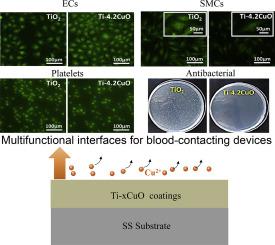Biomaterials Advances ( IF 7.9 ) Pub Date : 2020-06-17 , DOI: 10.1016/j.msec.2020.111198 Qian Ren 1 , Lina Qin 1 , Fengjuan Jing 1 , Dan Cheng 1 , Yong Wang 1 , Mingyuan Yang 1 , Dong Xie 2 , Yongxiang Leng 1 , Behnam Akhavan 3 , Nan Huang 1

|
Multifunctional interfaces that promote endothelialisation, suppress the viability of smooth muscle cells (SMCs), prevent the adhesion and activation of platelets, while demonstrating antibacterial activity are of great interest for surface engineering of blood-contacting devices. Here, we report for the first time the high-power pulsed magnetron sputtering (HPPMS)/DC magnetron sputtering (DCMS) co-sputtering of Ti-xCuO coatings that demonstrate this required multifunctionality. The Cu contents and surface chemistry of the coatings are optimized, and the critical role of copper release on the viability of endothelial cells (ECs) and SMCs, platelet adhesion, and antibacterial activities is elucidated. Rutile phase is formed for Ti-xCuO coatings with Cu atomic concentrations in the range of 1.9 to 13.7 at.%. Rutile and nanocrystalline/amorphous structures were determined for the coatings with 16.8 at.% Cu, while an amorphous phase was observed for the coating with 33.9 at.% Cu. The Ti-xCuO coatings with higher Cu contents were more susceptible to corrosion, and the release rates of Cu ions increased with increasing the Cu contents, maintaining a stable releasing state for up to 28 days. The Ti-xCuO coatings with optimum microstructure and Cu contents of 3.1 and 4.2 at.% promoted the viability and proliferation of ECs, suppressed the viability of smooth muscle cells, inhibited the platelet adhesion and activation, and showed excellent antibacterial activities. Such multifunctionality was achieved in one-pot through controlled copper ions release in the presence of titanium oxides such as TiO2 and Ti2O3 on the surface. The Ti-xCuO coatings developed through HPPMS/DCMS co-sputtering are attractive for surface modification of blood-contacting materials such as implantable cardiovascular devices.
中文翻译:

Ti-xCuO涂层的反应磁控共溅射:血液接触设备的多功能接口。
多功能接口促进内皮化,抑制平滑肌细胞(SMC)的活力,防止血小板的粘附和激活,同时展现出抗菌活性,这对于血液接触设备的表面工程非常感兴趣。在这里,我们首次报告了Ti-xCuO涂层的高功率脉冲磁控溅射(HPPMS)/ DC磁控溅射(DCMS)共溅射,证明了这种所需的多功能性。优化了涂层的Cu含量和表面化学性质,阐明了铜释放对内皮细胞(EC)和SMC的活力,血小板粘附和抗菌活性的关键作用。Ti-xCuO涂层形成金红石相,其Cu原子浓度在1.9至13.7 at。%的范围内。对于具有16.8原子%Cu的涂层,确定了金红石和纳米晶/非晶结构,而对于具有33.9原子%Cu的涂层,观察到了非晶相。Cu含量较高的Ti-xCuO涂层更容易受到腐蚀,Cu离子的释放速率随Cu含量的增加而增加,并保持稳定的释放状态长达28天。具有最佳组织和Cu含量分别为3.1和4.2 at。%的Ti-xCuO涂层可促进ECs的活力和增殖,抑制平滑肌细胞的活力,抑制血小板的粘附和活化,并表现出出色的抗菌活性。通过在钛氧化物(如TiO)存在下控制铜离子的释放,一锅实现了这种多功能性 而观察到具有33.9原子%的Cu的涂层为非晶相。Cu含量较高的Ti-xCuO涂层更容易受到腐蚀,Cu离子的释放速率随Cu含量的增加而增加,并保持稳定的释放状态长达28天。具有最佳组织和Cu含量分别为3.1和4.2 at。%的Ti-xCuO涂层可促进ECs的活力和增殖,抑制平滑肌细胞的活力,抑制血小板的粘附和活化,并表现出出色的抗菌活性。通过在钛氧化物(如TiO)存在下控制铜离子的释放,一锅实现了这种多功能性 而观察到具有33.9原子%的Cu的涂层为非晶相。Cu含量较高的Ti-xCuO涂层更容易受到腐蚀,Cu离子的释放速率随Cu含量的增加而增加,并保持稳定的释放状态长达28天。具有最佳组织和Cu含量分别为3.1和4.2 at。%的Ti-xCuO涂层可促进ECs的活力和增殖,抑制平滑肌细胞的活力,抑制血小板的粘附和活化,并表现出出色的抗菌活性。通过在钛氧化物(如TiO)存在下控制铜离子的释放,一锅实现了这种多功能性 Cu离子的释放速率随Cu含量的增加而增加,并保持稳定的释放状态长达28天。具有最佳组织和Cu含量分别为3.1和4.2 at。%的Ti-xCuO涂层可促进ECs的活力和增殖,抑制平滑肌细胞的活力,抑制血小板的粘附和活化,并表现出出色的抗菌活性。通过在钛氧化物(如TiO)存在下控制铜离子的释放,一锅实现了这种多功能性 Cu离子的释放速率随Cu含量的增加而增加,并保持稳定的释放状态长达28天。具有最佳组织和Cu含量分别为3.1和4.2 at。%的Ti-xCuO涂层可促进ECs的活力和增殖,抑制平滑肌细胞的活力,抑制血小板的粘附和活化,并表现出出色的抗菌活性。通过在钛氧化物(如TiO)存在下控制铜离子的释放,一锅实现了这种多功能性 抑制血小板的黏附和活化,并表现出优异的抗菌活性。通过在钛氧化物(如TiO)存在下控制铜离子的释放,一锅实现了这种多功能性 抑制血小板的黏附和活化,并表现出优异的抗菌活性。通过在钛氧化物(如TiO)存在下控制铜离子的释放,一锅实现了这种多功能性2和Ti 2 O 3在表面上。通过HPPMS / DCMS共溅射开发的Ti-xCuO涂层对于血液接触材料(例如可植入的心血管设备)的表面改性具有吸引力。

























 京公网安备 11010802027423号
京公网安备 11010802027423号